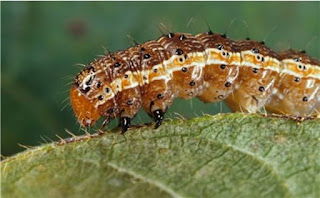In February, the Nigerian Ministry of Agriculture and Rural development confirmed the invasion of the Armyworm in 22 states of the country, with serious damage to cereal crops, chief of which is maize.
Knowing Armyworm Species
The African armyworm (Spodoptera exempta), is an African moth. It is a very deleterious pest, capable of destroying entire crops in a matter of weeks. The armyworm gets its name from its habit of "marching" in large numbers from grasslands into crops. African armyworms tend to occur at very high densities during the rainy season, especially after periods of prolonged drought. Recent discoveries pointed out that the latest infestation in Nigeria and in West Africa sub-region are not from the “True” African army worm” but a fresh pest that belongs to the same Family and Genus as the African army worm, but an entirely different species; frugiperda.
Spodoptera frugiperda is known as the “Fall Armyworm” Its scientific name is derived from its feeding habits:frugiperda is Latin for lost fruit as it can destroy crops. It is native to the Americas, and are presumed to have found their way to East Africa though immigrants carrying their egg by air or by sea. Their caterpillars mainly attack maize crops. They will eat everything in an area, and once the food supply is exhausted, the entire "army" will move to the next available food source. The larvae are a dull yellow to gray with stripes running down the length of the body. The mature caterpillar is about 1.5–2.0 inches (38–51 mm) in length.
The Fall Armyworm (S.frugiperda). An infestation is hard to detect, as the caterpillars migrate to new feeding areas in the cool of the night. Caterpillars can lay waste to an entire crop in a few days when they reach maturity stage.
 |
| Armyworm |
Causing fundamental damages
The bad news, however, is that either it is the African armyworm (Spodoptera exempta) or the Fall Armyworm (Spodoptera frugiperda); both are capable of destroying entire crops in a matter of weeks when left to multiply. They multiply fast with a short life cycle, hard to detect and resist chemicals by hiding in the cereal stalks. The larvae feed on all types of grasses, early stages of cereal crops (e.g., corn, rice, wheat, millet, sorghum, sugar cane, and occasionally on coconut S.frugiperda have obviously shown a preference for maize. Maize ranked among the top 3 staple foods in Nigeria, estimated annual production is about 10 million tonnes, with total demand being 15 million tonnes, there is already about 5million tonnes gap of national demand, the current infestation pose a threat to national food security and availability of maize in the country, as the 22 affected states spread across the six geo-political zones.
 |
| Infected Maize |
Saving Crops from Armyworm Invasion Using Pro-Active Measures: Farmers and Actors’ Roles
The Nigeria government has said it requires N2.98 billion to curb the armyworm infestation of farmlands across the country. Although the United Nations Food and Agriculture Organization (FAO) had pledged to support the country in its fight against the armyworm infestation, there is still need for more pro-active measures from the farmers as well as the Nigerian government. For example, the government of Zambia, have identified the threat posed by this insect pest, took it as a national war, and at a point made use of the nation's Army jets to spray insecticide on the heavily affected zones, a case of “the army against the army” you want to say! Through extension service, they also maintained a high level of sensitization and education among farmers.
On the part of the farmers, there is need to improve farm hygiene and use improved varieties of maize resistant to the worms. Farmers can also use control measures like chemical control, biological control, and the use of botanicals that is the use of plant extracts (Organic control), it is, however, worthy of note that chemical control, even though proven to be the most effective is not environmental friendly and therefore not the most efficient. The pest cannot be completely eradicated, but all hands must be on deck to ensure it is adequately put under control this year, Farmers, Ministry of Agriculture and Agricultural Research Institutes should as a matter of urgency work together in developing an effective weapon that can work against the biological army.
Ahmed Olanrewaju Aliyu.
Agribusiness consultant
07035720065.
Agritreasure@gmail.com.
Comments
Post a Comment